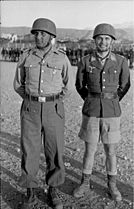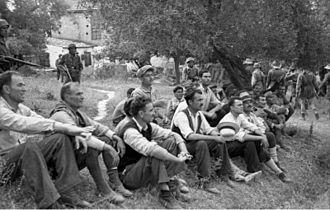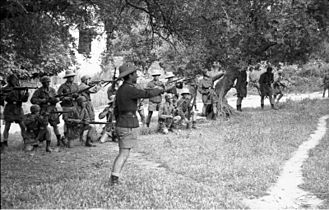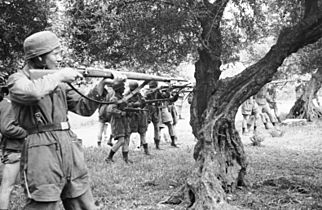Massacre of Kondomari facts for kids
Quick facts for kids Massacre of Kondomari |
|
|---|---|
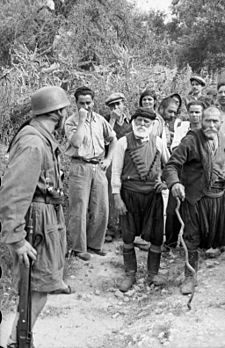
People from Crete facing German paratroopers before the killings began in June 1941.
|
|
| Location | Kondomari, Chania, Crete, Kingdom of Greece (under German occupation) |
| Coordinates | 35°30′25″N 23°51′22″E / 35.50694°N 23.85611°E |
| Date | 2 June 1941 |
| Weapons | Machine guns and rifles |
| Deaths | 23 (German estimate), 60 Cretan men (other sources) |
| Perpetrators | German paratroopers (Fallschirmjäger) from the III Battalion of Luftlande-Sturm-Regiment led by Oberleutnant Horst Trebes. This happened after orders for punishment from Generaloberst Kurt Student. |
The Massacre of Kondomari (Greek: Σφαγή στο Κοντομαρί) was a tragic event during World War II. On June 2, 1941, German paratroopers, also known as Fallschirmjäger, killed many male civilians from the village of Kondomari in Crete. This was the first of several acts of punishment carried out by the Germans on the island.
The killings were ordered by General Kurt Student. He wanted to punish the people of Crete for fighting back during the Battle of Crete. This battle had ended just two days earlier with Germany taking control of the island. A German war reporter, Franz-Peter Weixler, took photos of the massacre. These photos were found 39 years later in German archives by a Greek journalist.
Contents
Understanding the Event
Where is Kondomari?
Kondomari is a village on the northern coast of Crete. It is about 18 kilometers (11 miles) west of the city of Chania. It is also close to the Maleme airstrip, which was a very important place during the battle.
The Battle of Crete: A Quick Look
The Battle of Crete started on May 20, 1941. German paratroopers launched a huge airborne attack to capture important places on the island. The Maleme airstrip was one of the most vital spots. Taking control of it allowed the German air force (Luftwaffe) to bring in many more soldiers and supplies. This helped them win the battle.
On the first day of the battle, German paratroopers landed near Maleme, including in the Kondomari area. They faced strong resistance from New Zealand soldiers. Local Cretan civilians also joined the fight, even though they had simple weapons like knives and axes. The German paratroopers suffered heavy losses. Nearly 400 out of 600 soldiers were killed or wounded. Their commander, Major Otto Scherber, was among those killed.
Why the Germans Punished Civilians
During the Battle of Crete, the local people and Allied soldiers fought very hard. They caused many casualties among the German forces. The Germans were surprised by this strong resistance from civilians. They believed that only trained soldiers should fight in a war.
German reports claimed that Cretan civilians were attacking paratroopers. When these reports reached the German High Command, General Hermann Göring ordered General Kurt Student to investigate and punish the locals. So, General Student quickly ordered a wave of punishments against the people of Crete. These punishments were to happen right after the island surrendered on May 31. He said there should be no formal trials. The same German units who had fought the locals were to carry out these actions.
The Kondomari Massacre
Following General Student's order, the people of Kondomari were blamed for the deaths of some German soldiers found near their village. On June 2, 1941, four trucks full of German paratroopers surrounded Kondomari. These soldiers were from the same unit that had fought in the area. They were led by Lieutenant Horst Trebes.
All the men, women, and children in the village were forced to gather in the village square. Then, the German soldiers chose a group of men as hostages. The women and children were allowed to leave. The chosen men were led to nearby olive groves. There, they were shot by the German soldiers.
The exact number of victims is not fully clear. German records say 23 men were killed. However, other sources suggest the number was closer to 60. The entire event was filmed by Franz-Peter Weixler, a German war reporter.
Photos from the Event
What Happened Next
The day after the Kondomari massacre, the same German unit continued their actions. They went to the village of Kandanos and destroyed it, killing most of its people.
After the summer of 1941, Franz-Peter Weixler, the reporter who took the photos, was removed from the German army. He was later accused of working against Nazi Germany. This was because he shared uncensored photos and information about the paratroopers' actions in Crete, including the Kondomari pictures. He was also accused of helping some Cretans escape. Weixler was arrested and imprisoned in 1944.
After the war, in November 1945, Weixler gave a written report about the Kondomari massacre during the Nuremberg Trials. In 1955, he returned to Kondomari. The villagers welcomed him, as was their tradition. Weixler told them he was just following orders that day. However, the villagers were still upset. One survivor told the others that their hospitality duty was done, and they should leave. So, all the villagers left, leaving Weixler alone.
Weixler's photo negatives from Kondomari were found in 1980 by a Greek journalist named Vassos Mathiopoulos. At first, he didn't know where the photos were taken. Later, another journalist, Kostas Papapetrou, did a lot of research and figured out they were from Kondomari. After that, Weixler's photos became widely known.
In July 1941, Horst Trebes, the officer who led the Kondomari massacre, received a high award for his leadership during the attack on Crete. He was killed in action in Normandy three years later, in 1944.
After Germany surrendered, General Kurt Student was captured by the British. In May 1947, he faced a military court. He was accused of mistreating and killing prisoners of war and civilians in Crete. Greece asked for him to be sent to Greece for trial, but this was refused. Student was found guilty of some charges and sentenced to five years in prison. However, he was released in 1948 due to health reasons. He lived until 1978.
Kondomari has been officially recognized as a martyred village. There is a memorial in the village that lists the names of the victims. It also has a wall with tiles showing pictures of the event.
See Also
- Alikianos executions
- List of massacres in Greece
- Razing of Kandanos
- War crimes of the Wehrmacht


